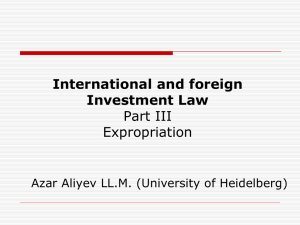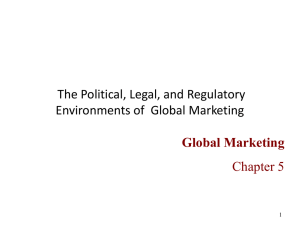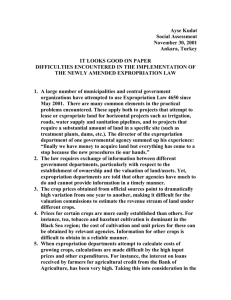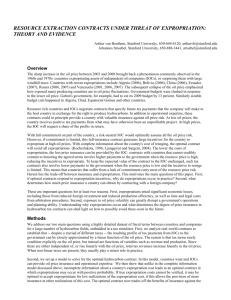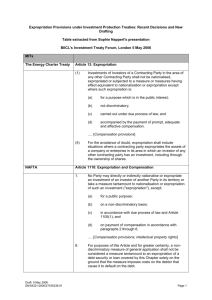Preliminary Research on Urban Land Supply Control Model
advertisement
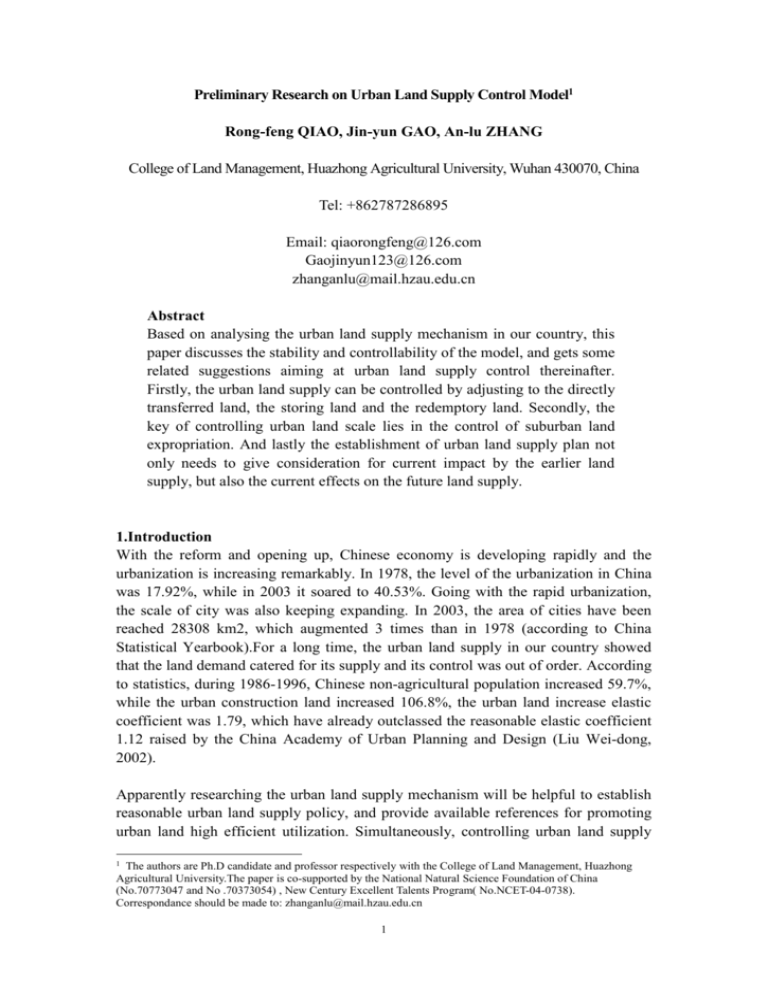
Preliminary Research on Urban Land Supply Control Model1 Rong-feng QIAO, Jin-yun GAO, An-lu ZHANG College of Land Management, Huazhong Agricultural University, Wuhan 430070, China Tel: +862787286895 Email: qiaorongfeng@126.com Gaojinyun123@126.com zhanganlu@mail.hzau.edu.cn Abstract Based on analysing the urban land supply mechanism in our country, this paper discusses the stability and controllability of the model, and gets some related suggestions aiming at urban land supply control thereinafter. Firstly, the urban land supply can be controlled by adjusting to the directly transferred land, the storing land and the redemptory land. Secondly, the key of controlling urban land scale lies in the control of suburban land expropriation. And lastly the establishment of urban land supply plan not only needs to give consideration for current impact by the earlier land supply, but also the current effects on the future land supply. 1.Introduction With the reform and opening up, Chinese economy is developing rapidly and the urbanization is increasing remarkably. In 1978, the level of the urbanization in China was 17.92%, while in 2003 it soared to 40.53%. Going with the rapid urbanization, the scale of city was also keeping expanding. In 2003, the area of cities have been reached 28308 km2, which augmented 3 times than in 1978 (according to China Statistical Yearbook).For a long time, the urban land supply in our country showed that the land demand catered for its supply and its control was out of order. According to statistics, during 1986-1996, Chinese non-agricultural population increased 59.7%, while the urban construction land increased 106.8%, the urban land increase elastic coefficient was 1.79, which have already outclassed the reasonable elastic coefficient 1.12 raised by the China Academy of Urban Planning and Design (Liu Wei-dong, 2002). Apparently researching the urban land supply mechanism will be helpful to establish reasonable urban land supply policy, and provide available references for promoting urban land high efficient utilization. Simultaneously, controlling urban land supply 1 The authors are Ph.D candidate and professor respectively with the College of Land Management, Huazhong Agricultural University.The paper is co-supported by the National Natural Science Foundation of China (No.70773047 and No .70373054) , New Century Excellent Talents Program( No.NCET-04-0738). Correspondance should be made to: zhanganlu@mail.hzau.edu.cn 1 has been one of the most important means by which our government controls the macro-economy. Generally speaking, properly increasing the supply of the urban land first-grade market will promote the development of the real estate; on the contrary, will restrain the development. When China restrains the superheated urban real estate investment, besides adjusting the interest rate, controls strictly the transferable farmland and decreases urban land supply. Therefore, on the basis of the real condition to construct the mathematic model, to analyse the urban land supply and control mechanism, will have important reference value for controlling the urban real estate and the macro-economy as well as their stable development. At present, the urban land supply model is still a research task waiting for discussing. How to decide synthetically the urban land supply on the aspects of the time, the scale, the amount and the position will affect the sustainable utility of the urban land resource and development of urban economy. Through constructing control model, combining stability and controllability analysis, this paper makes preliminary discussion to the urban land mechanism. There are many researches aiming at the urban land supply. Lu Xing-hai mentioned that there are two main resources in the urban land supply in advancing urbanization, which are to increase the relative supply of the urban stocking land and the expropriation land (Lu Xing-hai, 2004). Cheng Ye mentioned in his article that the measures our government takes to control the land utility was to induct, restrict and control the land management mainly by using community measurement, such as the division of land use, the layout of the land utility, the laws, the regulations, the policy, etc.(Cheng Ye., 2001). Liu Wei-Dong draw a conclusion that the urban land supply should keep a reasonable proportion of different character using land to promote the forming of city ideal space based on the need of city development (Liu Wei-dong, 2002). Overseas, the control of the urban land supply is mainly by confirming urban boundary, establishing land exploitation permission system, designing the land supply plan, etc. which are from carrying out the city planning system. Geoffrey K.Turnbull established a mathematic model aiming at the city development fee and the confirmation of urban boundary on the urban land supply; furthermore, he has made elaborate analysis and discussion (Geoffrey K. Turnbull, 2004). However, in these researches, there are fewer discussions to the urban land self-supply mechanism. 2.Why should the government control the urban land supply? Because of the land finity, the natural land supply keeps changeless haply. Furthermore, under the current science and technology and use conditions, the area of land available tends to inchmeal reduction as a result of the natural disaster and predatory and destructive snatch. According to the economic elasticity theory, land natural supply has no elasticity. But aimed at some idiographic urban land type, its quantity of supply has elasticity by land expropriation and land consolidation. In China, land expropriation has been strictly restrained and the stocking land is too limited, so the urban land supply is uptight with a low elasticity. 2 From the Reform and Opening, Chinese economics has been dramatically developing at a high speed, the quantity of population of city has been more than 300 million, and the disposable income per capita increases duratively. Therefore, people strongly itch for the product of real estate. In 1998 government abrogated the welfare housing and broadened the housing credit policy, which motivated the development of the real estate. Even as the statistical data show, the investment growth rate of national real estate development is up to 32% in the first half of 2002. The high-speed development of the real estate industry caused the huge land demand. Because it markedly possesses the ability to embody actual characteristic of land demand of the real estate industry, the valid demand of town house can reflect the actual land need trend. For example, the amount of the valid demand of town house got to 2225.1 km2 in the centre city of Wuhan in 1998, however, to 2003 it rose to 5311.6 km2 with 2.4 time of which in 1998. Such huge increasing need bets your boots to cause city to satisfy with the huge need of the construction land (data source: The land storage supply center of Wuhan).At the same time, the increment of the city population and the expansion of the scale also stimulates the demand augmentation that uses the ground to the industry, business and infrastructures by all means. In the light of supply and demand equilibrium analysis to the urban land, there are some conclusions which can be gained: 1)the elasticity of urban land supply is small, and the total amount of that correspondingly exists limit. In a period of aftertime, each land using type amount can't exceed which is defined to the maximum by the land using general planning inside the total programming time. That’s to say, there are two asymptotic lines provided with the figure 1, dash line T1 and T2. 2) the urban land demand enlarges increasingly along with the development of the economy. 3) some measures must be taken to enhance the government income by adjusting and controlling urban land. If government indulges the urban land purveyance, when the urban land market calms down into balance or basically stability, the government income may be reduced. In Figure 1 at the point B1 the land supply and demand is attained balanced, and the land income is the dimension of the rectangle OP1B1L1; When the primary market supply is out of control, the land supply curve will shift to the right and the equilibrium point will be B2, as a result, the land income is the dimension of the rectangle OP2B2L2. The land price drops when government strengthen land delivery volume and land market reach the balance of land supply and demand, the land income might not increase, that is to say, it can't be totally guaranteed that the area of the first rectangle will certainly be smaller than the area of later rectangle. So, some measures must be taken to fortifiedly control the supply of land primary market, guarantee government's income maximization. 3 Figure 1 Equilibrium of Urban Land Supply and Demand 3. A Control Model In terms of the supply mode of the land primary market, there’s a systematic block diagram (Fig. 2) can be made to explain it. In the China land primary market at present, it is mainly to expropriate collective land and urban stocking land for the source of which the city supplies with. The sum of the volume of the two sorts can be appeased for the total amount of land demand. And one part of this total amount comes through selling land ownership to attain it, the other can be acquired which is purchased or other way to enter government land store base, then transferred the land use right. Because not all store land is purchased, the part of which is still in land store base have not been sold and become new urban stock land again partly, just delay in supplying time. In addition, according to the stipulations of relevant laws and regulations of land management in China, government can purchase or regain some land that has already sold the right to use the land directly in certain circumstances; this part of land has entered government land stored base again. At present, because regional land storage systems are different, it is different that the way of land use right is assigned. After all in some provinces all the urban land must firstly be stored by government, and then has been put in order through land development and arrangement; other places urban land use right can be sold directly out of storing. Considering actual land supply mode in China, the model is applied d to analyse urban land purveyance illustrated in Fig. 2. Collective Expropriation Land Urban Stock Land Directly transferrable Land Availabe Volume of Urban Land Supply Actual Volume of Urban Land Supply Redemptory Land Storing Land Assignment Figure 2 Systematic Block Diagram of Urban Land Supply According to above-mentioned argumentation, the control model can be correspondingly set up. It is U (k) to denote the quantity of collective expropriation land on k period, set as control variable; it is X1 (k) and X2 (k) respectively to figure the quantity of urban stock land and storing land, set as the state variable; actual 4 volume of urban land supply Y (k) is set as the output variable. Urban stock land and outskirts expropriation land is the main resource which is suitable for the land demand. And what primarily meets the market demand of urban land is the volume of actual assignment land, which is shown as two parts in the block diagram above, and one part of it comes from directly transferred land, another from the city storing land. In order to make the model succinct, define the parameter α is the directly transferred land ratio of the total available supply land, and this directly transferred land have not entered urban storing land base. In order to adjust and control the urban land market, it might not be all the storing land is being all sold out, so define β is the assignment ratio of urban storing land, some of which origins from old city rebuilding and urban idle land. And the parameter θ is defined the proportion between the redemptory land and the actual volume of urban land supply. Based on the systematic block diagram and relevant assumption, can set up the following equalities. Y (k ) U (k ) X 1 (k ) X 2 (k )......... .......... .......... .......... .......... .(1) X 1 (k 1) X 2 (k )(1 ) Y (k )......... .......... .......... .......... .......... ..( 2) X (k 1) [U (k ) X (k )](1 ) X (k ) Y (k )......... .......... ...( 3) 1 2 2 The equality (1) indicates that, the supply volume of urban land this issue is the sum of directly transferred land and the directly transferred part of which has been in urban land store base; the equality (2) shows that the quantity of the urban stock land in the next period will be the sum of the redemptory land and the unsupplied urban land which has been in land storing base in this period; the equality (3) interpreted that, the volume of the urban store land in the next period quantity of land will be combined the redemptory land which is retrieved by government and the unsupplied urban land which has entered the store land base in this period, thereinto, the available volume of urban land supply is made up of the quantity of stock land and the expropriation land in this period. It must be mentioned in the article that the redemptory land is not usually regained in this period but the before. For analysis convenience of question, this part of the redemptory land use the volume of the actual volume of urban land supply as the comparison radix. That is to say, the land redemptory land quantity equals to the product of θ and the actual volume of urban land supply. Actually redemptory land quantity is generally smaller than which of the supply land in this period in China, so, these three parameters are all less than 1. According to the equality (1), (2) and (3), build the control model: X 1(k 1) αθX 1(k) (1 - β θβ) X 2(k) αθU(k) X 2(k 1) (1 - α αθ) X 1 (k) ( θβ- β) X 2(k) (1 - α αθ) U (k) Y(k) αX 1(k) βX 2(k) αU(k) Written by the matrix type, 5 X (k 1) AX(k) BU(k) Y(k) CX (k) DU(k) 1 1 In the equations set, A= , B= 1 , C= , , D= I, I is the identity matrix. This control model is the discrete-time steady linear model. 4. Analysis of the Model We can simply definite the systematic stability as following: the system is in the balance state in advance, has deviated from this state after being interfered. Removing the interference of this system, it can get back to the initial balance state, and then this system is gradual stabilization. Setting 1 , 2 ,..., n as the characteristic number of the systematic matrix A, according to the relevant theory, the necessary and sufficient condition of gradually stability is that all the characteristic number are not greater than 1, i.e. i 1 ,i=1,2,…,n. So, if the land supply system would reach the balance, the characteristic value of systematic matrix A should be smaller than 1. Through calculating, this systematic matrix characteristic value of model should meet the following equality: 2 ( ) ( 2 2 1) 0 , let d= , get 2 2 2 1,2 d d 4( d 1) 2 When 1, 2 <1, i.e. So when 1 , d d 2 4( 2 2 d 1) <1, can get 2 1 , then 1, 2 <1, The system model can reach the balance t at this moment. Using the land supply model, we try to make the system be balanced. The solution is k made up of two parts mainly. A x(0) is a system response to the initial state. k 1 A i 0 k (i 1) BU (i) is the response to the inputs. When it is gradually stable, the system’s response to the initial state will tend towards zero with the increase of k, because the characteristic number of matrix A is smaller than 1.Control variables and state vectors sum variable output which has indicated in the article. Then, we can take the place 6 k 1 of Y (k ) C A k x(0) A k ( i 1) BU (i ) DU (k ) i 0 . When k is increased, the influence of initial state on the output of the system is smaller and smaller. 1 , the volume of the When the urban land control model is satisfied with stock land and storage land under the initial state will have lesser influence on the urban stock land, storing land and the urban land supply after a long time. And the stock and storage level of urban land will spontaneously approach to balance state with time. Setting Xe as the balance state of the system, we can calculated for Xe = (I-A)-1BU(k). Then we can know the stock and storage level of the urban land under balance state. That is to say, the land supply level is determined by the amount of land 1 , it will not expropriation. On the contrary, if this system is satisfied with advance gradually stabilization. Because the system responses to the initial state make the systematic state variable fluctuate, the supply amount of urban land will fluctuate, even bigger and bigger. Then, it will influence the equilibrium of supply and demand and produce the bad chain reaction of the land market. So, it is necessary to maintain the relationship of the rate of land selling, rate of land storage and rate of land reclaiming reasonable, thus make land supply keep certain stability. The model is hoped to be controlled, namely as we adjust the variable in the model, the expected results can be reached by the system dynamic operation. Obviously, the anticipated level that we cared about most is systematic output, namely whether the output volume of urban land could reach the level that we have established some time before; if can reach, the model is called output-controllable. Adopting to adjust parameters the system output can be controllable. Supposing its initial state X (0) = x0 , model output volume at the certain moment N> 0, can reach the target value Y (N) = y n . Due to Y(k) CX (k) DU(k) , N 1 Y ( N ) C A N x(0) A N (i 1) BU (i ) DU ( N ) , deforming i 0 N 1 C A N (i 1) BU (i ) + DU (N ) N = yn CA x(0) , writing as matrix form is the vector i 0 D CB CAB CA N 1B U = yn CAN x(0) , and U U ( N ), U ( N 1),..., U (0) T .If let this equation group be solved, condition that should 7 be met is that the rank of the matrix D CB CAB CA N 1 B is equal to the rank of the matrix y n CA N x(0).Therefore, if the parameters 、 and are rationally controlled and adjusted, the equation group will have solution and the model will be controllable. That’s to say, the expected land supply target can be reached for some time under a certain initial state. This model can be used to predict the state variable and output variable, namely to divine the volume of the stock land, storing land and urban land supply. According to the following formula, k 1 X (k ) A k x(0) A k ( i 1) BU (i ) , and i 0 k 1 Y (k ) C A k x(0) A k (i 1) BU (i) DU (k ) i 0 If land expropriation level is known from initial state to the prediction k period and the parameters 、 and , the volume of the stock land, storing land and urban land supply will be obtained in the k period. 5.Conclusions Control of land supply is the key to adjust the amount of land demand and supply for balance. The government should channel off the demand of urban land to stabilize the urban land market on the basis of the control of its supply. Analyzing the control model there will be some conclusions as following. Firstly, one of the means to control the urban land supply is that government should rationally frame the amount of directly transferred land, the storing land and the redemptory land. When the control model is asymptotically stable, the fluctuation amount of the urban land supply by expropriated land inceptively can be suppressed gradually to degradation. And when the model output is controllable, government can achieve the expected amount of the urban land supply by adjusting and controlling those three variables. According to the forenamed equality (1), if the urban land supply need to increase in the short period, the amount of directly transferred land and the storing land should be enhanced appropriately, which is equal to augment the parameter α and β; contrarily, the adjustment should be reverse. Secondly, the sticking point of the urban land supply control lies on the land expropriation control which happens on the rural-urban fringe. When each of the transferred land amount of the directly transferred land, the storing land and the redemptory land keeps invariant basically, in response to the land output formula 8 k 1 Y (k ) C A k x(0) A k (i 1) BU (i) DU (k ) , the quantities of the urban land i 0 supply primary rests with the land expropriation on the urban-rural fringe after a period of time. Maybe the stocking urban land can be satisfied with the land demand in a short time, but considering in a long run the origin of urban land use scale expansion mostly will hail from the occupied farm land which is around city. This process is also anastomotic with which is actually happening. Consequently, in order to control city expansion, government should strictly restrain banlieue land expropriation. Lastly, the mechanism of urban land supply should be taken into account when its demand and supply is explored. Based on the land output formula, urban land supply is not only related with the current land expropriation and stocking land, but also the transferred land, the storing land and the redemptory land in prophase; and current urban land supply is not only effected by which in the prior period, but it will impact on the future land supply. If we want to concretely measure the influence, in terms of land output formula, let the current quantity of expropriation land equal to 0, input other corresponding data, then we can calculate it easily. Therefore, government should considerately analyse the land supply mechanism, according to the practical situation, select the correct parameters and time then institute the rational urban land supply policy which is farthest suit for the demand for the land market balance. 6. Discussion The assumption of this control model is that the level of directly transferred land, the storing land and the redemptory land is invariable, that’s to say, parameter 、 and are all constants. But in reality those parameters are all the time variables. So the model can be optimized to linear nonsteady control model. Otherwise, the model just discuss the quantity of urban land supply, doesn’t involve the relationship between price and quantity of the stocking land, incremental land and redemptory land. As a result, the analysis need to be further. Ultimately, the model also doesn’t embedded refer to the urban land demand, if we build a new model which treat urban land supply as the input of urban land demand system, then it will be more instructive and profitable. 7. References National Bureau of Statistics of China. China Statistical Yearbook(2003). China Statistics Press, 2004 Zhang Jin-shui, Economic Cybernetics of Deterministic Dynamic System. Tsinghua University Press. 1989, 29-30 Zeng Xiang-jin. Elements of Economic Cybernetics. Science Press. 1995, 55-85 Hal R. Varian, translated by Fei Fang-yu. Microeconomics:Modern Viewpoint. Shanghai Shenghuo-Dushu-Xinzhi Joint Publishing Company and Shanghai 9 People's Publishing House, 2003, 360-365 ZHANG An-lu, MAO Hong. Rural-urban land conversion and The primary land market equilibrium. Journal of Central China Normal University:Natural Sciences, 2004, 34(2) Cheng Ye. Primary Research on Land Use Control and Land Use Zoning Control. China Land Science, 2001, 15(4), 22-25 Yang Gang-qiao. Discussion about the equilibrium of urban land supply and demand. China Land Science, 1998, 12(4), 21-23 Yang Gang-qiao. Study on Controlling Town Land Sprawl in Foreign Countries. Modern Urban Research, 2004, 19(111), 57-60 Lu Xin-hai. Land Demand and Supply in Urbanization. China Real Estate, 2004, 1, 30-32 Liu Wei-dong. Study on Land Supply and Development in Urban China. City Planning Review, 2002, 15(4), 37-40 Geoffrey K. Turnbull. Urban Growth Controls: Transitional Dynamics of Development Fees and Growth Boundaries [J]. Journal of Urban Economics, 2004, 55(2), 215-238 10



